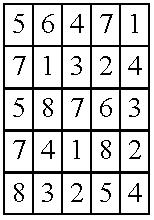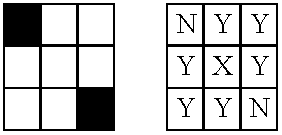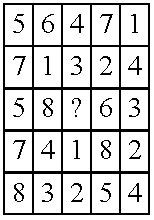Fast building of masks for use in incremental printing
a mask and printing technology, applied in the direction of digitally marking record carriers, visual presentations using printers, instruments, etc., can solve the problems of affecting the appearance of masks, and consuming a lot of drying steps, so as to reduce the conspicuousness of banding and ink-to-ink interactions, and reduce the effect of hue shi
- Summary
- Abstract
- Description
- Claims
- Application Information
AI Technical Summary
Benefits of technology
Problems solved by technology
Method used
Image
Examples
Embodiment Construction
Neighborhood Constraint
A generalization of the constraint concept will be introduced here in order to illustrate the idea of weighter. The neighborhood constraint will assign weights to the candidates depending on the distance in number of passes to a value already present in any given neighbor. For instance, in NSP format:
This weighter will assign a weight to all possible candidates, for any given position, taking already present neighbors into account. This constraint can be applied to the shaded, empty position of the following mask. ##STR9##
The previous pixel in the same row is assigned to pass eight. This means, applying the constraints defined for (-1,0), that eight will be weighted zero, and seven and one (both at a distance between one and eight inclusive) will be weighted 0.1.
The upper neighbor is seven. Applying the constraint defined for (0,-1) will give a weight of 0.5 to the candidate seven. But there was already a weight for the seven, so a combined weight has to be ca...
PUM
 Login to View More
Login to View More Abstract
Description
Claims
Application Information
 Login to View More
Login to View More - R&D
- Intellectual Property
- Life Sciences
- Materials
- Tech Scout
- Unparalleled Data Quality
- Higher Quality Content
- 60% Fewer Hallucinations
Browse by: Latest US Patents, China's latest patents, Technical Efficacy Thesaurus, Application Domain, Technology Topic, Popular Technical Reports.
© 2025 PatSnap. All rights reserved.Legal|Privacy policy|Modern Slavery Act Transparency Statement|Sitemap|About US| Contact US: help@patsnap.com



